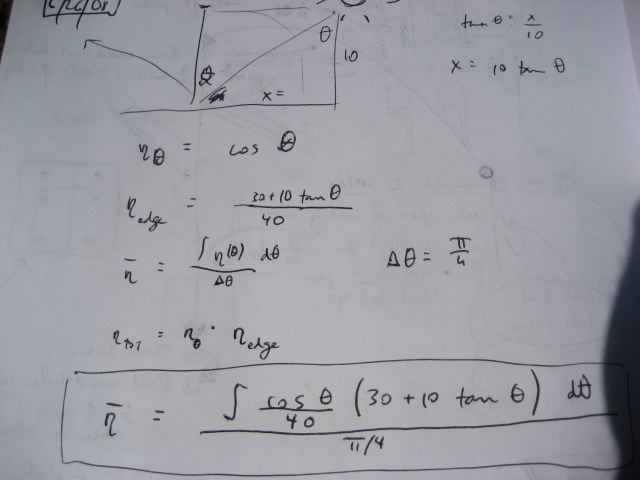Solar Collector Calculations: Difference between revisions
Jump to navigation
Jump to search
(New page: If we use a passive tracking arrangement for the collector, with only seasonal adjustment, then we have two losses: #Loss due to the sun not being perpendicular to the array - if theta is ...) |
No edit summary |
||
| Line 3: | Line 3: | ||
#Loss due to edge effects - when the sun is not directly overhead, part of the collector tube is not illuminated (assuming length of collector tube is the same as the length of the reflectors) | #Loss due to edge effects - when the sun is not directly overhead, part of the collector tube is not illuminated (assuming length of collector tube is the same as the length of the reflectors) | ||
The overall efficiency - for the 6 hours of the day around high noon - is: | The overall average efficiency (eta bar) considering these two losses - for the 6 hours of the day around high noon - is: | ||
[[Image:collector efficiency.jpg]] | [[Image:collector efficiency.jpg]] | ||
Revision as of 16:12, 26 June 2008
If we use a passive tracking arrangement for the collector, with only seasonal adjustment, then we have two losses:
- Loss due to the sun not being perpendicular to the array - if theta is the angle measured from the position of the sun at high noon - then the efficiency stemming from this varies as cosine(theta)
- Loss due to edge effects - when the sun is not directly overhead, part of the collector tube is not illuminated (assuming length of collector tube is the same as the length of the reflectors)
The overall average efficiency (eta bar) considering these two losses - for the 6 hours of the day around high noon - is:
This value - I estimate to be around 75% - for the average efficiency of the collector without daily tracking.
Someone please run this on the computer or analytically and fill in the exact value.
